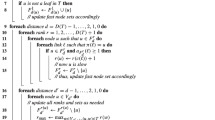Abstract
Data broadcast has been considered a promising way of information dissemination to a massive number of users in a wireless communication environment. Reducing user-waiting time is a major problem in developing a data broadcast system. There are two approaches for this problem; One is to design a broadcast schedule at the server side which reduces the mean response time, and the other is to utilize a local cache at the user side which may respond to a user request instantly. Though these two approaches were addressed separately in the literature, they may be taken jointly for better performance. The performance of system with joint approach depends on several factors such as broadcast schedule, cache size, cache management strategy, etc. In this paper we analyze response time in a data broadcast system with joint approach in which information items are structurally related with each other as in WWW. Based on the worst-case assumption, we derive a lower bound on the system performance for a given set of broadcast schedule, cache size, and cache management strategy. This result will be of help for designing and developing a data broadcast system. We support our analysis by carrying out an extensive simulation on some interesting proposed broadcast schedules and cache management strategies.
Similar content being viewed by others
References
S. Acharya, M. Franklin and S. Zdonik, Prefetching from a broadcast disk, in: Proceedings of International Conference on Data Engineering, 1996.
D. Aksoy and M. Franklin, Scheduling for large-scale on-demand data broadcasting, in: Proceedings of IEEE INFOCOM, 1998.
M. Ammar, Response time in a teletext system: an individual user's perspective, IEEE Transactions on Communications 35(11) (1987).
M. Ammar and J.W. Wong, The design of teletext broadcast cycles, Performance Evaluation 5(4) (1985) 235–242.
M. Ammar and J.W. Wong, On the optimality of cyclic transmission in teletext systems, IEEE Transactions on Communications 35(1) (1987) 68–73.
R. Jain and J. Werth, Airdisks and airraid: modeling and scheduling periodic wireless data broadcast, Computer Architecture News 23(4) (1995) 23–28.
S. Jiang and N. Vaidya, Response time in data broadcast systems: mean, variance and trade-off, in: Proceedings of Workshop on Satellite Based Information Services (WOSBIS), Dallas, TX, 1998.
C.J. Su and L. Tassiulas, Joint broadcast scheduling and user's cache management for efficient information delivery, Wireless Networks 6(4) (2000) 279–288.
C.J. Su, L. Tassiulas and V.J. Tsotras, Broadcast scheduling for information distribution, Wireless Networks 5(2) (1999) 137–147.
L. Tassiulas and C.J. Su, Optimal memory management strategies for mobile computing, IEEE Journal on Selected Areas in Communications 15(7) (1997) 1226–1238.
N.H. Vaidya and S. Hameed, Scheduling data broadcast in asymmetric communication environments, Technical Report 96-022, Computer Science Department, Texas A&M University, College Station, TX (1996).
Author information
Authors and Affiliations
Rights and permissions
About this article
Cite this article
Kim, JD., Kim, CK. Response Time Analysis in a Data Broadcast System with User Cache. Telecommunication Systems 22, 119–139 (2003). https://doi.org/10.1023/A:1023486819826
Issue Date:
DOI: https://doi.org/10.1023/A:1023486819826




